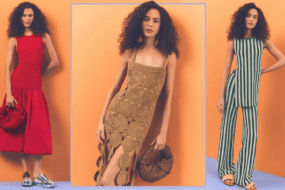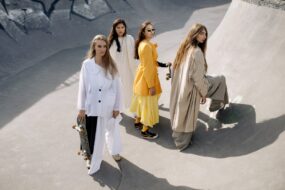
Fashion has long been a mirror reflecting the cultural, social, political, and economic changes in society. From ancient draped garments to 21st-century minimalist streetwear, fashion has evolved not only in aesthetics but also in meaning and function. It speaks volumes about identity, gender, class, and even ideology. As fashion cycles repeat and evolve, the journey from vintage to modern trends reveals a fascinating narrative of creativity, rebellion, innovation, and reinvention. This essay explores the history of fashion, its transformation over the decades, and how past styles continue to influence contemporary trends.
The Origins of Fashion: Function Meets Status
The earliest records of fashion date back to ancient civilizations like Egypt, Mesopotamia, Greece, and Rome. In these societies, clothing primarily served practical purposes—protection from the environment and identification of social status. Egyptian clothing, for instance, was made from linen, ideal for the hot climate. Fashion in ancient Greece and Rome emphasized draped garments like togas and chitons, often symbolizing status, gender, and occasion.
While these early societies did not have “fashion” in the modern sense of constant change and innovation, style played a symbolic role. Rich colors, luxurious fabrics, and intricate accessories were reserved for the elite, marking the beginning of fashion as a status symbol.
The Medieval and Renaissance Eras: Fashion Becomes Art
By the Middle Ages, fashion in Europe became more elaborate, particularly among the nobility. The introduction of tailoring brought structure to garments, and clothing began to be shaped to the body. The Renaissance (14th to 17th century) marked a turning point where fashion truly began to flourish as an art form. Wealthy patrons in Italy and France wore opulent fabrics like silk and velvet, adorned with embroidery, pearls, and lace.
The Renaissance period also introduced the idea of changing trends. As European courts competed in opulence and style, fashion began to shift seasonally. Artists like Leonardo da Vinci and Michelangelo, though primarily known for their paintings and sculptures, also influenced the aesthetics of dress.
The 18th Century: Extravagance and Revolution
The 18th century was characterized by the extravagance of French aristocracy. Marie Antoinette, the Queen of France, became a fashion icon, popularizing voluminous gowns, powdered wigs, and accessories that symbolized excess. Fashion was theatrical, elaborate, and deeply intertwined with politics.
However, the French Revolution brought a dramatic change. Extravagant styles fell out of favor, and simpler, more utilitarian clothing became fashionable. This era marks the beginning of fashion as a reflection of societal change. What people wore was not only about appearance—it was a political statement.
The 19th Century: Industrialization and the Birth of Couture
The 19th century was a transformative era for fashion. With the Industrial Revolution came technological innovations that revolutionized the production of textiles and garments. The sewing machine, invented in the mid-1800s, made clothing production faster and more accessible.
This century also saw the birth of haute couture in Paris. Charles Frederick Worth, considered the first fashion designer, established a fashion house in the 1850s and created custom designs for elite clients. His work introduced the concept of the designer as an artist and helped formalize the fashion industry.
Victorian fashion reflected strict social codes. Women wore corsets, crinolines, and bustles, emphasizing modesty and structure. Men wore tailored suits, top hats, and pocket watches. Fashion during this period was elaborate and heavily influenced by social class and gender norms.
Early 20th Century: A Century of Change
The early 20th century brought seismic shifts in fashion. The influence of World War I led to practical changes in women’s clothing. Skirts became shorter, corsets loosened, and women began wearing trousers for the first time, particularly during the 1920s. The flapper dress, with its drop waist and fringe, became a symbol of rebellion and modernity.
Coco Chanel revolutionized women’s fashion during this era. She introduced simple, elegant, and comfortable clothing, including the iconic little black dress and tweed suits. Her designs emphasized freedom of movement and modern elegance, reflecting the changing roles of women in society.
Men’s fashion also relaxed slightly, with the rise of the three-piece suit and more casual tailoring. The 1930s and 1940s were influenced by Hollywood glamour and wartime austerity. Utility clothing became common, while film stars like Katharine Hepburn and Cary Grant shaped mainstream fashion with their charismatic styles.
The Post-War Era: 1950s and 1960s
The 1950s marked a return to femininity in fashion. Christian Dior’s “New Look” brought back the cinched waist, full skirt, and structured silhouette, celebrating luxury and beauty after years of war. This decade was marked by domestic ideals and consumerism, and fashion followed suit with polished, idealized styles.
However, the 1960s brought cultural revolution and with it, a shift in fashion. Youth culture became the driving force behind trends. London’s Mod scene introduced mini skirts, bold prints, and androgynous styles. Designers like Mary Quant and André Courrèges broke away from traditional fashion, embracing modernism, pop art, and freedom of expression.
This was also the era when fashion became democratized. Ready-to-wear lines became popular, and trends spread quickly through television and magazines. Fashion was no longer the exclusive domain of the elite.
The 1970s and 1980s: Expression and Excess
Fashion in the 1970s was defined by freedom and self-expression. Influenced by counterculture, music, and social change, this decade saw a mix of styles: bohemian looks, disco glam, punk rebellion, and ethnic-inspired fashion. Bell bottoms, tie-dye, platform shoes, and fringe became ubiquitous. The rise of unisex fashion challenged traditional gender norms.
In contrast, the 1980s were marked by boldness and extravagance. Shoulder pads, neon colors, and power suits symbolized ambition and economic success. Pop icons like Madonna, Prince, and Michael Jackson became fashion leaders, setting trends that reached global audiences.
Designer labels gained prominence during this time. Names like Giorgio Armani, Versace, and Jean-Paul Gaultier became synonymous with luxury and innovation. Fashion became more commercialized, and branding started to influence buying decisions.
The 1990s: Minimalism and Subcultures
The 1990s took a stark turn from the excesses of the previous decade. Minimalism became the defining aesthetic. Clean lines, neutral tones, and simple silhouettes ruled the runways. Designers like Calvin Klein and Helmut Lang popularized understated elegance.
At the same time, subcultures flourished. Grunge, led by bands like Nirvana, introduced a disheveled, anti-fashion style—flannel shirts, ripped jeans, and combat boots. Hip-hop fashion, with baggy jeans, oversized shirts, and sportswear, gained popularity thanks to artists like Tupac and Aaliyah.
The rise of supermodels like Naomi Campbell, Kate Moss, and Cindy Crawford turned models into celebrities, further merging fashion with pop culture. Magazines, music videos, and television began to heavily influence fashion trends.
The 2000s: Technology and Fast Fashion
The early 2000s brought about major changes in how fashion was consumed. The rise of the internet and social media platforms like MySpace and later Instagram allowed trends to spread instantly. Fast fashion brands like Zara, H&M, and Forever 21 capitalized on this by producing inexpensive, trendy clothing at breakneck speed.
Y2K fashion—low-rise jeans, crop tops, rhinestones, and metallic fabrics—reflected a blend of futuristic and nostalgic aesthetics. Celebrities like Britney Spears and Paris Hilton epitomized this look. At the same time, the emo and scene subcultures emerged, with their distinct hairstyles, skinny jeans, and band tees.
Sustainability, although not yet mainstream, began to surface as concerns over environmental impact and labor conditions in the fashion industry gained attention.
The 2010s: Individualism and Sustainability
In the 2010s, fashion became more fragmented and personalized. Social media, especially Instagram and YouTube, allowed influencers and everyday users to become style authorities. Streetwear exploded, led by brands like Supreme and Off-White, and collaborations between luxury houses and sportswear brands became the norm.
Normcore—a trend of dressing in intentionally dull or average clothing—challenged traditional ideas of fashion. Meanwhile, gender-fluid fashion gained momentum, with designers and brands embracing androgynous and unisex designs.
The conversation around sustainability grew louder. Documentaries like The True Cost exposed the dark side of fast fashion, prompting a shift toward ethical and eco-conscious consumption. Vintage and second-hand fashion gained popularity, especially among Gen Z, who sought unique pieces and a smaller environmental footprint.
Today and Beyond: Blending Past and Future
Modern fashion is an eclectic mix of the past and the present. Vintage styles are constantly being reinterpreted—whether it’s the return of 90s baggy jeans, 70s prints, or 2000s nostalgia. At the same time, technology is shaping the future of fashion in new ways.
3D printing, AI design, and virtual fashion shows are transforming how garments are created and consumed. The metaverse and digital wearables have introduced virtual clothing that exists purely online. Sustainability remains a major concern, pushing brands toward circular fashion models, biodegradable fabrics, and transparent supply chains.
Inclusivity and diversity are now central themes in the industry. Representation of different body types, races, genders, and abilities has improved, though there’s still room for progress. Consumers now demand authenticity, ethics, and identity from the brands they support.
Conclusion
The evolution of fashion from vintage to modern trends tells a story far deeper than fabric and design—it is the story of human history, values, identity, and innovation. Fashion has moved from being a symbol of status and tradition to a dynamic and inclusive form of self-expression. It has responded to wars, revolutions, cultural movements, and technological advances, adapting and reinventing itself constantly.
As we move further into the 21st century, the line between past and future in fashion continues to blur. While we embrace cutting-edge innovations, we also celebrate and revive vintage styles. In this cyclical journey, fashion remains not only an art form but also a language through which generations speak, challenge norms, and imagine new futures.






















